7 Detailed Steps for Marketing Your Mobile App
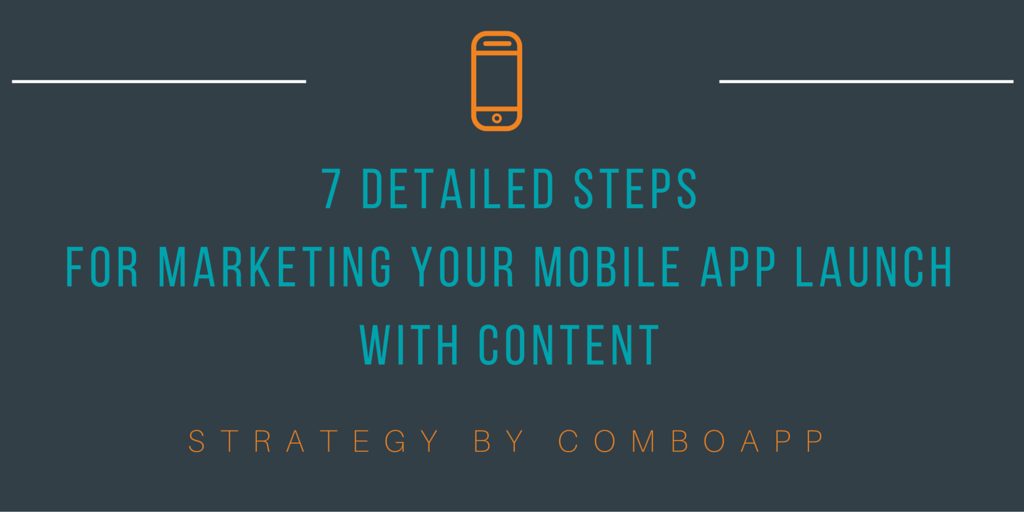
It’s hard to get your mobile app noticed among 3 million others out in the marketplace.
This is what’s keeping mobile app developers up at night.
Ask anyone on Quora or turn to app marketing agencies, like Comboapp.com, where I work as a Content Manager.
The mobile ecosystem is so saturated and volatile that it’s easy to get lost determining the most suitable marketing methods for mobile app promotion.
And as I’ve seen too often in the industry, mobile app developers aren’t integrating a content strategy, often viewing it as a minor priority.
This might have something to do with how time-consuming it can obe to develop relationships over time with content marketing, but for mobile app owners and marketers out there who’ve never recognized its effectiveness, consider this an intervention.
I’m going to demonstrate the ways in which a great content strategy can serve as an amplifier of paid marketing efforts, helping app owners cope with these two main issues:
Attracting New Users to your mobile app
Why would someone spend time or use storage space on their phone for your app?
Through blog posts, app reviews, and earned media coverage, you’re able to tell potential customers why your app is so great by describing unique features or helpful functions.
Here’s an example of a positive review for Key Ring app:

As part of a brand exposure campaign for the app, we focused on contacting bloggers and opinion leaders in different target categories. Think moms, money-saving tips, and lifehacks.
Additionally, we leveraged a blogger ambassador group to create a tailored campaign for Key Ring with pitches on app utility and unique features.
As a result of blog coverage and social media mentions, Key Ring noticed a considerable uptick in the number of app downloads as well as feedback from the target market via commenting.
Retaining Existing Users
Localytics research shows that users abandon 1 in 4 mobile apps after a single use. And as average cost per loyal user reached the $4 threshold, it has become crucial for app owners to create loyal user bases for their apps.

This can be done with an effective content strategy that keeps audiences engaged and actively participating in the gaming or app community.
In the rest of this article, learn how to develop the right strategy for your own app with these 7 smart steps to take with content during launch:
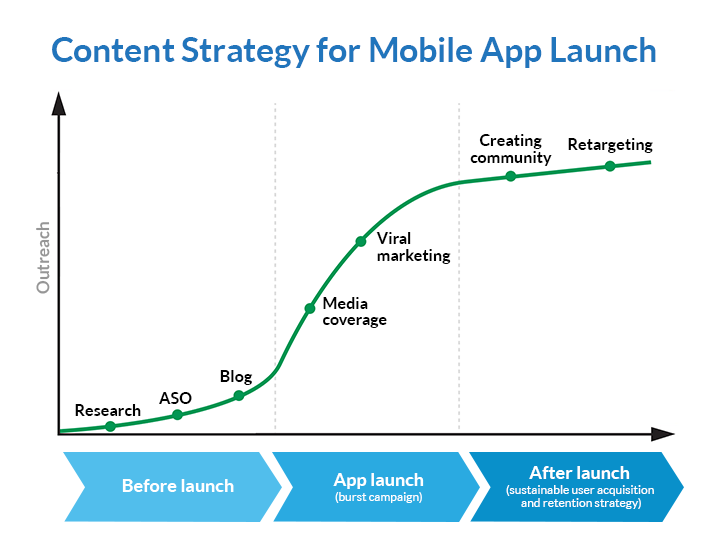
(Source: ComboApp)
1. Research Your Target Audience
Surveying the industry and competitors can help with identifying audiences to target with content.
Begin searching for thematic blogs, articles, and interviews relevant to your app.
Luckily, app developers and publishers often share their experiences with successful app launches as well as typical pitfalls.
For example, this great Medium community, Startups, Wanderlust, and Life Hacking, where you can soak up valuable information on how to approach the market.
Defining the Right Audience
When you create a persona of your typical user, you will define the most suitable content types and formats for maximum reach and engagement.
This can be done by determining a general target audience within the app’s category.
Some examples:
- If your app is a B2B utility app, it would be safe to assume that you should target corporate employees and small company CEOs.
- If targeting millennials with messaging or emoji apps, don’t ignore their love of memes and GIFs.
- If your primary users are seniors, like in the case of health apps, stick to images, videos and get conversational.
Some data to boot:

(Source: Fractl and BuzzStream Survey)
Understanding The Challenges of Your Target Audience
Remember that content you create should be relevant to the target audience of the app.
You can succeed at this by highlighting the typical problems and challenges of your audience. Their research on topics related to your app can provide valuable information for the creation process.
As an added bonus, what you uncover can also be utilized in keyword strategy, allowing you to reach more potential users organically.
Keep these basic questions in mind as you source answers for their challenges:
- What are their pain points?
- What are they interested in learning or reading about?
- How can content help with solving daily challenges and questions?
- How will the app help solve their problems and needs?
We often look in places where people usually ask for expert advice or share opinions:
Industry and Community Forums:
Find industry-related forums or local forums, if your app provides local service. Notice the most popular and discussed topics and pay attention to threads that fall under your app topic.
For example, parenting forums can be a good source of topic ideas for an educational app:
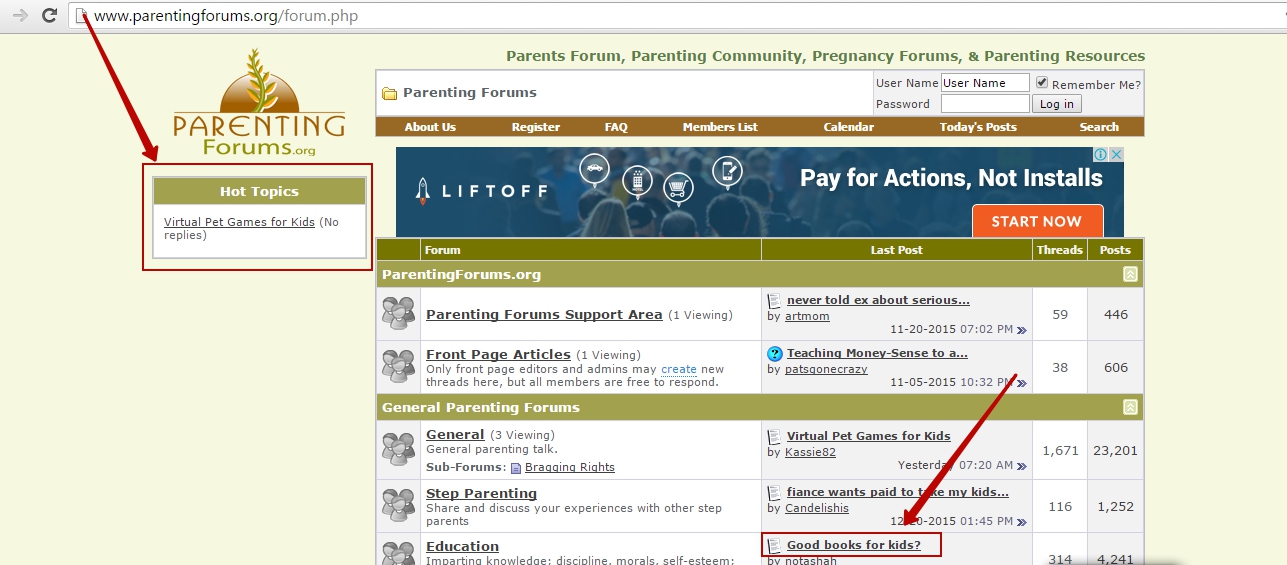

Social Media and Buzzsumo:
Buzzsumo.com helps define the most popular content which people are sharing across social media.
By using thematic keywords like the ones included in your app title, description and keyword section, you can find some great ideas for posts and interesting articles via “Most Shared.”
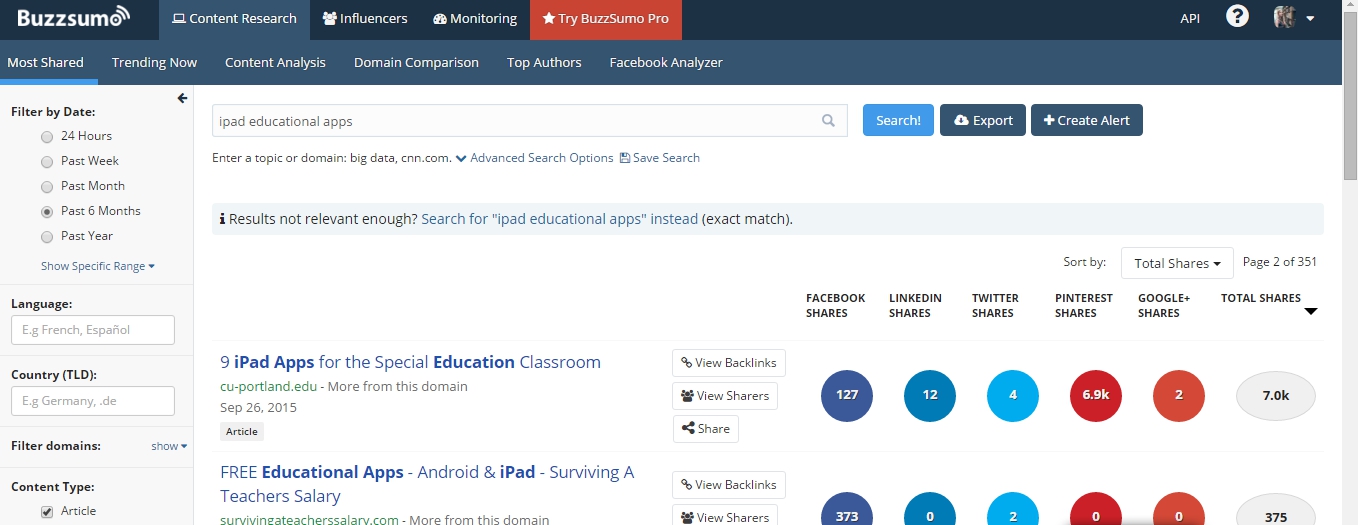
You’ll find that even though you may not directly be searching for questions related to pain points, that many of these articles aim to answer a question or address a need.
Each published piece of content is doing what you are looking to do, so mine that inspiration as you see fit.
Quora:
A question-and-answer website where people, and your potential users, look for expert advice.
A question on Quora.com is a clear indication that someone, or many people, are in need of a particular piece of information related to a topic.
Again, try thematic keywords to find common search queries. Use different filters to surface the most popular questions available, or filter by time to find new questions emerging around a topic that you might want to jump in front of.

2. App Store Optimization (ASO)
An apps’ title, screenshots, description and included keywords make a huge impact on whether or not it gets discovered among app store search engines.
Optimizing for this is thus incredibly important.
Here’s an example of a professional ASO job we implemented for Bungee Mummy, a free arcade game:

Notice the high-quality screenshots showing gameplay to potential users (above).
Additionally, an informative description contains popular keywords for the game (below).
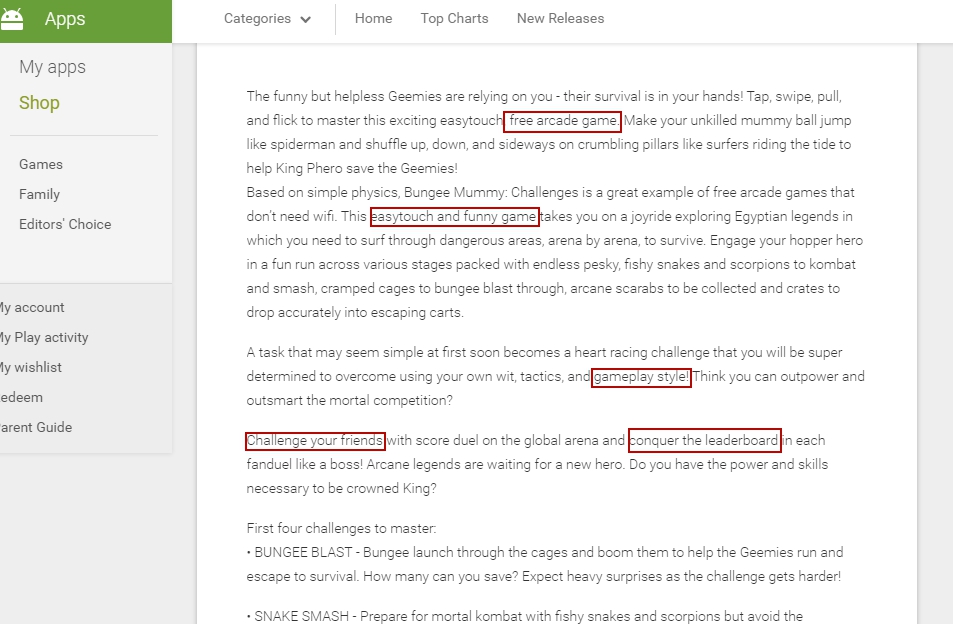
Extra tips on impactful ASO tactics:
- Concentrate on long-tail keywords
- Don’t stuff app descriptions and titles with too many keywords (3-4 is enough)
- Provide screenshots that will show main app features
According to a report from VentureBeat, search engine algorithms pay more attention to this in-app content now — don’t forget to make it relevant.
By optimizing in-app content, you increase your chances of ranking higher within app stores where users are browsing for new content to download.
3. Create a Content Calendar
If you already have a site or blog that’s designed to deliver value over time, it should also be leveraged to engage with potential app users via relevant and interesting owned content during the course of an app launch and beyond via burst campaigns.
An editorial calendar is the easiest way to plan ahead when executing your content strategy as it will help you map out posts on a consistent basis for maximum exposure.
We create an editorial calendar a few months an advance, defining main publication topics and seasonal posts, while leaving space for industry news and trends updates.
Take a look:

Why a few months in advance?
Planning content a month or two ahead will leave enough time for:
- Proper research on a particular topic
- Creating some buzz across digital platforms and in the community
- Updates and other marketing activities
- A localization on new market can be synced with local media coverage and announcement posts
- Preparing case studies about app successes
According to AppAdvice, 20% of apps are abandoned right after they are downloaded.
Blog updates are great for keeping users engaged and interested, giving them more incentive to go back into your app for further use.
Moreover, if you publish unique and relevant content, users will turn to you as an authority, returning to your blog (and app) for more.
4. Create Buzz Around an App Launch
An app launch is the best time for getting exposure on industry blogs and media channels.
Just as burst campaigns help to acquire critical user growth for a new app, media exposure can put an app on the map and increase the number of organic downloads over time.
Try to leverage significant audiences by getting your app reviewed by those who matter the most in the industry.
How?
Just by asking them the right way.
Here are some tips on how to forge relationships with relevant influencers:
Create a Pitch
Explain why your app is unique and interesting. Nobody will review the app if your description is ordinary and modest.
Be brief, include initial info and tell why your app is worth promoting:
- App name
- Why it’s unique
- Link to iTunes/Google Play
- Some screenshots
- A very short description of target audience and app features
- Contact details
Example of a Pitch:

Find Niche Bloggers
Think fashion bloggers for retail apps or general app review sites like CnetDownload.com, IGN, Gizmodo, AppScout.
There are a number of media relation tools you can use to create a media list:
- GroupHigh
– Software that allows to research niche blogs and handles email communication with bloggers - >MyMediaInfo
– Tool that finds the contact information for editors, writers, and bloggers - Sellhack
– Browser extension that uncovers emails from social media profiles
You can also approach journalists and editors from news outlets using the search function on LinkedIn.
Just type the name of the media organization, select the “People” category and mine the results:

Just Keep Pitching
While 40% of journalists write about only 10% of the apps they’re pitched, don’t get discouraged. It takes time and a well-perfected pitch to catch the attention of an industry expert for a great review.
But take it from a 16-year-old app developer, Lachi Agnew, who reached out to his local newspaper — big exposure is always worth it.
5. Add a Viral Component
Most of us know that you can increase content outreach tenfold by producing something that gets shared. And that kind of world of mouth marketing is more effective than outdated and untrusted methods of direct advertising.
By adding some shareable elements to your content, you can incentivize people to spread the word about your app to their family, friends, peers and even followers online.
Some well-tested components of viral content:
Emotion – Content that evokes happiness, anger, fear or nostalgia becomes viral.
Vanity – People love to share information that makes them look good. Runtastic app received millions of impressions and organic downloads from users who shared their workout progress to Facebook.
Value – We feel good when providing something valuable to our friends. Think helpful content like tips, research, and statistic or case studies.
Nostalgia – Journal of Consumer Research shows that people are stimulated and even likely to spend more when this feeling is evoked.
Find great example (below) of a poster for Facebook made by Brazilian ad agency, Maximidia:

6. Establish a Community
Apps serve as a place where people with similar interests, needs and values connect.
By adding a social layer to an app, you can create a community around it. Doing so will result in a group of loyal and engaged users, who not only use your app but also act as advocates.
Just as the Runtastic app did (mentioned above) — allows users to share their personal experiences with your app, encourage feedback and begin building that community.
Alternatively, you can tap into existing app communities by contacting the opinion leaders in specific app categories. These are the key players who are followed by your potential mobile app users.
If promoting a gaming app, you could reach out to those who create gameplay trailers and walkthrough videos on YouTube — most of who are open to review offers.
YouTube channels are a great place to navigate to when looking for lists of opinion leaders, regardless of app type. For example, check out this list of Top 100 YouTube Game Channel.
From there, you would select a few channels that matched the criteria of your mobile app and then contact them via the “About” tab:
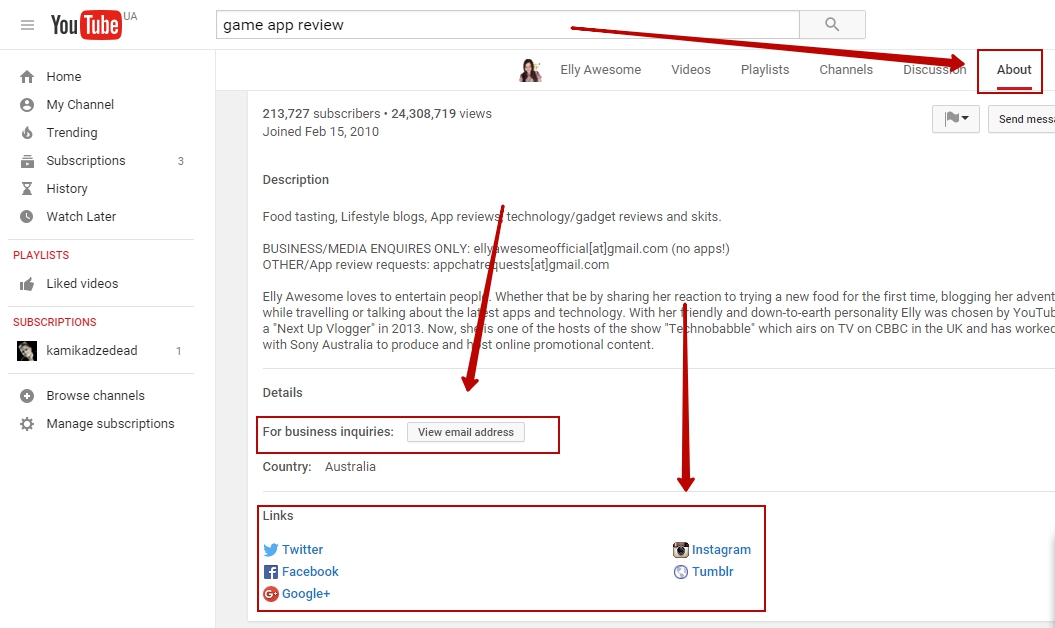
Below, find an iOS game review video that was a part of Curly app’s content strategy:

7. Retarget Interested Users
If someone has visited your website or blog and spent some time reading your content, chances are, they could also be interested in installing your app.
By segmenting users who previously showed interest in an app or app-related content with retargeting, you can stay top of mind and increase your chances of continued engagement.
Popular tools like Facebook ads can be utilized for this, and even Outbrain recently released their Customer Audiences feature, allowing marketers to serve content to people that have expressed interest in their brand before.
We suggest targeting users who have visited app “Download” or “Subscribe” pages, even though they may have left the site without taking action.
Do this by including those specific pages when creating your custom audience on Facebook or Outbrain:

Benefits of Well-Thought Content Strategy
A proper content strategy for your mobile app launch requires a lot of thought, research, planning, and execution.
If you follow the steps above carefully, though, it can lead to great successes such as these:
- Reaching target audiences in the right place and time
- Creating a community of loyal and engaged users
- Brand building around an app
- Increasing mobile app visibility and downloads
I hope you’ll find the techniques as valuable and enriching as we have!
Have you ever tried to pitch bloggers for app reviews? What types of tactics are you using marketing your mobile app with content? Share your thoughts and experience with us by commenting below!

